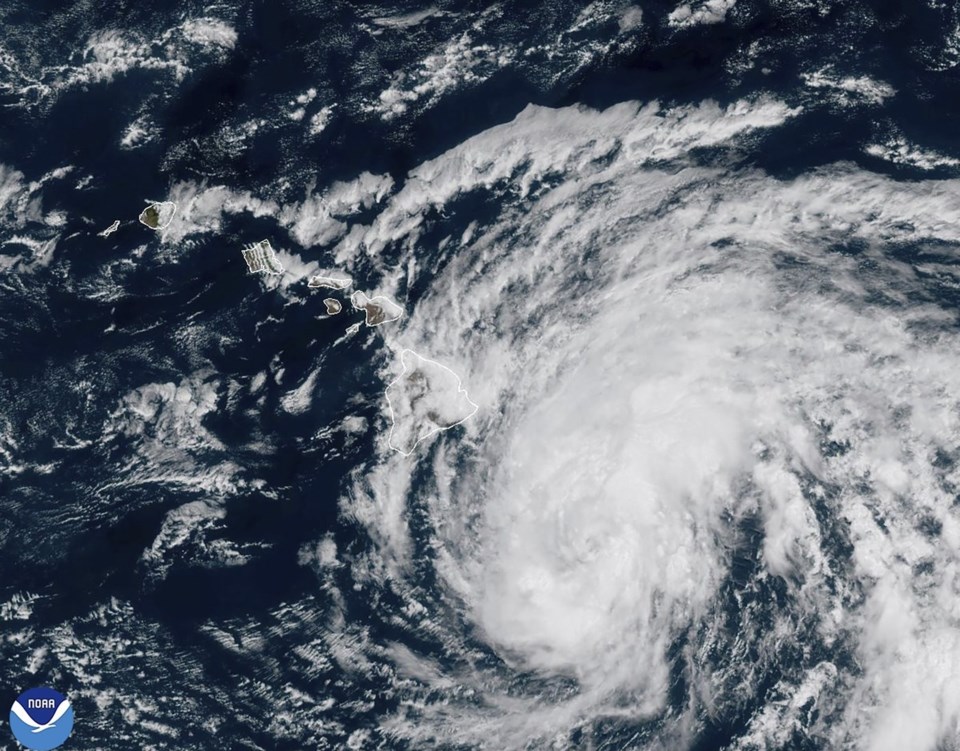HONOLULU (AP) — Tropical Storm Hone increased to a Category 1 hurricane while continuing its steady approach toward Hawaii late Saturday, forecasters said.
Hone (pronounced hoe-NEH) had top winds of 75 mph (120 kph), according to an 11 p.m. advisory by the Central 91Ô´´ Hurricane Center in Honolulu. The minimum threshold for a hurricane is 74 mph (119 kph).
A tropical storm warning remained in effect for the Big Island as the storm moved west at 12 mph (19 kph) about 105 miles (170 kilometers) south of Hilo, Hawaii, and about 275 miles (440 kilometers) southeast of Honolulu, the center said.
The hurricane center, part of the National Weather Service, previously said Hone was expected to remain just below hurricane strength at its peak Sunday through Monday.
Hurricane Gilma, still about 1,480 miles (2,380 kilometers) east of Hilo, increased to a Category 4 hurricane Saturday night.
Hone, whose name is Hawaiian for “sweet and soft,” drew near the islands Saturday with breezes that were expected to intensify and increase the wildfire risk for drier parts of the state even as memories are still fresh from last year's deadly blazes on Maui.
A red flag fire warning was in effect for the leeward sides of all islands through 6 p.m. on Saturday. The National Weather Service issues the alert when warm temperatures, very low humidity and stronger winds combine to raise fire dangers.
“They gotta take this thing serious,” said Calvin Endo, a Waianae Coast neighborhood board member who lives in Makaha, a leeward Oahu neighborhood prone to wildfires.
Most of the archipelago is already abnormally dry or in drought, according to the U.S. Drought Monitor. The winds are expected to be strongest where they blow downslope from higher terrain, over headlands and through passes, the hurricane center advised.
The situation recalls last year's deadly wildfires on Maui, which were fueled by . But while Hone presents high fire dangers, “it’s not on the magnitude of that,” weather service meteorologist Derek Wroe in Honolulu said Saturday.
The Aug. 8, 2023, blaze that torched the was the in more than a century, with 102 dead. Dry, overgrown helped spread the fire.
For years, Endo has worried about dry brush on private property behind his home. He's taken matters into his own hands by clearing the brush himself, but he's concerned about nearby homes abutting overgrown vegetation.
“All you need is fire and wind and we’ll have another Lahaina,” Endo said in the morning. “I notice the wind started to kick up already."
The cause of the Lahaina blaze is still under investigation, but by bare electrical wire and leaning power poles toppled by the strong winds.
The state’s two power companies, Hawaiian Electric and the Kauai Island Utility Cooperative, said they would be monitoring conditions this weekend and ready to shut off power if necessary to reduce the chance that live, damaged power lines could start fires.
Firefighters remained on the scene of a small blaze that started Friday night in Waikoloa, on the dry side of the Big Island, according to Big Island Mayor Mitch Roth. It was under control and did not cause any injuries or damage.
“We’re expecting to have bands of rain come through the day,” Roth said from Hilo, on the island's east side, where it was raining.
The island was getting enough rain later Saturday to cancel its red flag warning, though a warning remained in effect for the other islands, said Ian Morrison, a weather service meteorologist in Honolulu.
Officials were closing some Big Island beach parks in anticipation of dangerously high surf and preparing to open shelters if needed, Roth said.
The Hawaii Tourism Authority told travelers it’s still safe to come to the islands but recommended postponing outdoor activities.
The eastern and southeastern parts of the Big Island could get 5 to 10 inches (11 to 25 centimeters) of rain. The island could get sustained winds of 20 to 40 mph (32 to 64 kph) and gusts near 60 mph (97 kph), weather officials said.
Moving westward across the 91Ô´´ behind Hone was Hurricane Gilma. A separate 11 p.m. Saturday advisory said Gilma's “intensification rate has leveled off" and placed the storm 1,500 miles (2,410 kilometers) west of Baja California. The maximum sustained winds of 130 mph (215 kph) elevated the storm into the bottom of Category 4 hurricane status.
Forecasters had called for additional strengthening before gradually weakening as Gilma moves over cooler sea-surface temperatures and into a drier, more stable airmass.
Audrey Mcavoy And Jennifer Sinco Kelleher, The Associated Press



